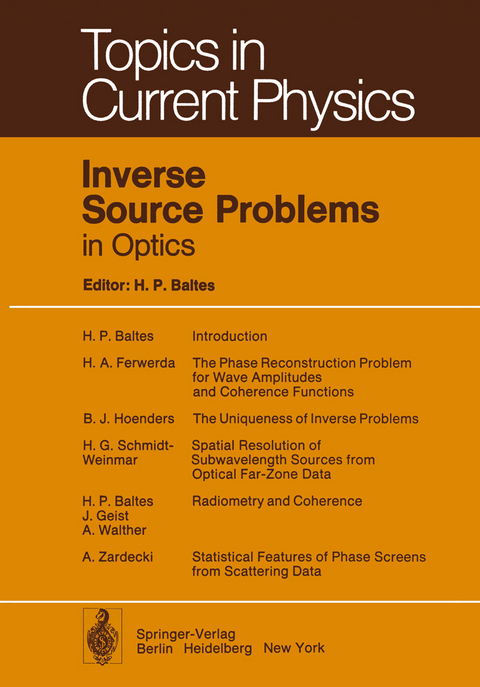
Inverse Source Problems in Optics
Springer Berlin (Verlag)
978-3-642-81274-3 (ISBN)
H. P. Baltes We begin the introductory chapter with a general definition of the inverse optical problem. Next, we discuss the role of prior knowledge and the questions of uniqueness and stability. We then review the various specific inverse problems in optics as well as the contents of Chapters 2 to 6. Finally, we summarize the notation in co herence theory. 1. 1 Direct and Inverse Problems in Optical Physics The "direct" or "normal" problem in optical physics is to :Jredict the emission or propagation of radiation on the basis of a known constitution of sources or scat terers. The "inverse" or "indirect" problem is to deduce features of sources or scatterers from the detection of radiation. An intuitive solution of the optical inverse problem is commonplace: we infer the size, shape, surface texture, and ma terial of objects from their scattering and absorption of light as detected by our eyes. Intuition has to give way to mathematical reconstruction as soon as we wish to analyze optical data beyond their visual appearance. Examples are the extrapola tion and deblurring of optical images, the reconstruction from intuitively inacces sible data such as defocused images and interferograms, or the search for information that is "lost" in the detection process such as the phase. Following CHADAN and SABATIER [1. 1], a general definition of inverse optical problems can be attempted as follows. We describe the sources and scatterers by the set (1.
1. Introduction.- 1.1 Direct and Inverse Problems in Optical Physics.- 1.2 Role of Prior Knowledge.- 1.3 Survey of Specific Inverse Problems.- 1.4 Notati on i n Coherence Theory.- References.- 2. The Phase Reconstruction Problem for Wave Amplitudes and Coherence Functions.- 2.1 Phase Reconstruction for Wave Ampl i tudes.- 2.2 Phase Reconstruction for Coherence Functions.- References.- 3. The Uniqueness of Inverse Problems.- 3.1 Summary of Inverse Problems.- 3.2 Inverse Diffraction.- 3.3 Non-Radiating Sources.- 3.4 The Determination of an Object from Scattering Data.- References.- 4. Spatial Resolution of Subwavelength Sources from Optical Far-Zone Data.- 4.1 Approaches to Superresolution.- 4.2 Partial Waves Associated with Complex Spatial Frequencies.- 4.3 Representations and Expansions of the EM Field.- 4.4 Band-Limiting at Variance with X-Localized Sources.- 4.5 High-Frequency Information in the Far Zone Given a X-Localized Source.- 4.6 X-Localized Sources Reconstructed from Far-Zone Data.- 4.7 Measurement of Phase and Magnitude of the Optical Radiation Pattern.- 4.8 Discussion.- References.- 5. Radiometry and Coherence.- 5.1 The Development of Radiometry.- 5.2 Coherence of Blackbody Radiation.- 5.3 First-Order Radiometry.- 5.4 Radiant Intensity and Angular Coherence.- 5.5 Radiation Efficiency.- 5.6 Second-Order Radiometry.- References.- 6. Statistical Features of Phase Screens from Scattering Data.- 6.1 Basic Formulation of the Statistical Problem.- 6.2 More General Detection and Coherence Conditions.- 6.3 Amplitude and Intensity Correlations.- 6.4 Number-Dependent Effects.- 6.5 Concluding Remarks.- References.- Additional References with Titles.
| Erscheint lt. Verlag | 8.12.2011 |
|---|---|
| Reihe/Serie | Topics in Current Physics |
| Vorwort | J.-F Moser |
| Zusatzinfo | XII, 204 p. |
| Verlagsort | Berlin |
| Sprache | englisch |
| Maße | 170 x 244 mm |
| Gewicht | 387 g |
| Themenwelt | Naturwissenschaften ► Physik / Astronomie ► Allgemeines / Lexika |
| Naturwissenschaften ► Physik / Astronomie ► Elektrodynamik | |
| Naturwissenschaften ► Physik / Astronomie ► Optik | |
| Technik | |
| Schlagworte | Inverses Problem • Optik |
| ISBN-10 | 3-642-81274-0 / 3642812740 |
| ISBN-13 | 978-3-642-81274-3 / 9783642812743 |
| Zustand | Neuware |
| Haben Sie eine Frage zum Produkt? |
aus dem Bereich


